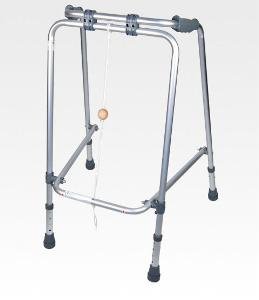YOUR QUICK GUIDE TO WALKING AIDS
FIRST PUBLISHED: 11/15/2017. LAST UPDATED: 8/7/2022
INCLUDES HOW TO FIT A WALKING AID
WHAT’S COVERED IN THIS ARTICLE:
We should always strive to be in our best physical condition and health by being active as much as possible and exercising, regardless of age.
Sometimes, however, for various reasons, there may come a time when a little assistance is required to help keep you steady, active and living your life safe from falling.
That assistance might be the use of a walking aid.
Walking aids can give benefit in many ways.
If you find you are becoming unsteady on your feet, they can provide stability to keep you standing. They can allow you to walk further if you are short of breath or fatiguing. And, they can make it easier for you to get around when in pain, recovering from injury or following surgery.
When these benefits of using a walking aid are felt, your confidence will also increase, knowing that getting about your day will be safer and easier.
All these benefits — yet many people still feel reluctant to use one, usually due to thoughts of it being a sign of losing independence or the shame of identifying with their use.
There is no need to feel either. When using a walking aid, you aren't losing any independence. Using a walking aid allows you to remain independent by keeping you safe from falling, allowing you to continue to do the things you want to do with greater ease.
If you have been told by a Health Professional that using a walking aid is required, drop any shame surrounding using one. Do not worry about what others think. Use it to allow you to get more out of life and use it confidently!
Let's now look at the common walking aids used and in which instances they are suitable.
Note Before: Always see a Physiotherapist before making any decisions about a walking aid. They will determine if you need one, which type is required and fit one for you.
Never borrow a walker from a friend or family member unless you're sure it's the right one required for you, it's the perfect fit, and it is in good condition.
TYPES OF WALKING AIDS
WALKING STICKS/CANES
Walking Sticks
Walking sticks can come in different shapes and sizes.
They can come with one, three or four points (see diagram).
They can be adjustable and even foldable to easily store away.
Walking sticks can provide added stability when moving about and can give confidence when entering unfamiliar or uneven territory.
If you feel yourself reaching for furniture now and then, a walking stick could benefit you.
As with any walking aid, ensure your walking stick is adjusted correctly for you.
ROLLATOR FRAME/FOUR-WHEELED WALKER
Rollator/4-Wheeled Walker
A rollator frame (or four-wheeled walker) is a medical device that helps people with mobility issues to walk independently.
It typically has four wheels, a seat, handrails and usually a basket you can put your belongings in. A rollator can be folded up for easy transport and storage.
Rollator frames are an excellent option for those who need a little extra help getting around but don't want to use a wheelchair. They provide support and stability while still allowing for some independence.
There are a few things to consider when choosing a rollator frame.
First, think about the size and weight of the person using it. Second, consider the terrain on which the frame will be used. A basic frame will suffice if it is used mainly on flat, even surfaces. However, a frame with bigger wheels and more features (such as suspension) might be necessary if it is used on rugged or hilly terrain.
TWO-WHEELED FRAME
Two-Wheeled walker
These walking aids are a mix of the Four-Wheeled Walker/Rollator (covered previous) and the Pick-Up Frame (covered next).
They often have skis on the back to allow continuous movement (no lifting required) when walking.
They should be used for times when you need to place some weight onto the walker (but not all) when walking causes you to become fatigued or unsteady on your feet.
They should not be used outdoors or on rougher terrain.
Some people use this walker as an alternative when travelling due to its lighter weight than the Four-Wheeled Walker/Rollator (above).
PICK-UP FRAME
Two-Wheeled Walker
This walker has no wheels and is picked up for every step. This walker does not allow for continuous movement.
These walkers are used when you need to place a significant amount of weight on the walker, with less weight through your legs (e.g. after a hip or knee replacement surgery).
Or, if you have limited walking ability and only walk very short distances. This could be due to painful joints in the legs, or other reasons.
As this walker has to be picked up and placed for every step, it can get tiresome if walking for longer distances.
It is not appropriate for times when only a little balance support is needed while walking. A two or four-wheeled walker is better in these instances.
HOW TO FIT A MOBILITY AID
It’s not uncommon to see walking aids fitted incorrectly.
Most of the time, they are set correctly by a Health Professional, but over time it’s very common for them to lose their correctly fitted settings.
Or, they are purchased without any education on how to use and fit them correctly.
It is recommended you see your Health Professional to have your walking aid fitted correctly. However, if required, here is a quick guide to assist you in fitting your walking aid.
Fitting A Walker and a Walking Stick
STEPS TO FIT A WALKING AID:
Wear your everyday shoes and place your arms by your side.
Keep your shoulder relaxed and not elevated.
Set the height of the walker/cane to your wrist crease. Bring the walking aid up to the crease of your wrist and lock the clip/screw in.
You should have a 20°-30° bend in your elbows when using the walker/cane and standing upright.
Once you have adjusted the length correctly, check that all clips/adjustments are fully locked.
WHICH SIDE TO USE A WALKING STICK ON
When using a walking stick for injury, weakness or pain, hold the walking stick on the opposite side of the injured leg or the stronger, unaffected leg.
If you are using a walking stick for balance, hold it in your stronger hand or what’s most comfortable. This will give you more control and stability.
Whichever reason you’re using a walking stick for. Make sure to practice using it before venturing out into the world.
SAFETY TIPS WHEN USING A WALKING STICk/FOUR-WHEELED WALKER
When using a mobility aid, you must use the walking aid properly and avoid any issues that could cause a fall.
For tips on properly using a walking aid to prevent falls, check out Step 10 of THE ULTIMATE GUIDE FOR FALLS PREVENTION FOR SENIORS.




